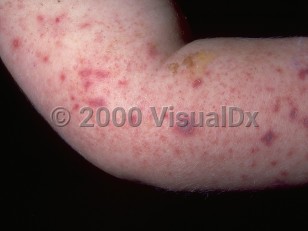Potentially life-threatening emergency
Acute meningococcemia in Child
Alerts and Notices
Important News & Links
Synopsis

Meningococcal disease is a rapidly progressive infection caused by Neisseria meningitides, a gram-negative diplococcus bacterium. Infection begins as a nonspecific viral-like illness that rapidly evolves (within hours) into 1 of 2 main presentations: meningitis or septicemia. Most cases are acquired through exposure to asymptomatic carriers via respiratory droplets. Children aged younger than 5 years and teenagers aged 15-19 are predominantly affected.
Complications of acute meningococcemia include pericarditis / myocarditis, disseminated intravascular coagulation (DIC), meningitis and permanent neurologic sequelae, septic arthritis, osteomyelitis, adrenal hemorrhage (Waterhouse-Friderichsen syndrome), gangrene, and death.
Related topic: chronic meningococcemia
Complications of acute meningococcemia include pericarditis / myocarditis, disseminated intravascular coagulation (DIC), meningitis and permanent neurologic sequelae, septic arthritis, osteomyelitis, adrenal hemorrhage (Waterhouse-Friderichsen syndrome), gangrene, and death.
Related topic: chronic meningococcemia
Codes
ICD10CM:
A39.2 – Acute meningococcemia
SNOMEDCT:
186365005 – Acute meningococcemia
A39.2 – Acute meningococcemia
SNOMEDCT:
186365005 – Acute meningococcemia
Look For
Subscription Required
Diagnostic Pearls
Subscription Required
Differential Diagnosis & Pitfalls

To perform a comparison, select diagnoses from the classic differential
Subscription Required
Best Tests
Subscription Required
Management Pearls
Subscription Required
Therapy
Subscription Required
References
Subscription Required
Last Updated:02/18/2024

